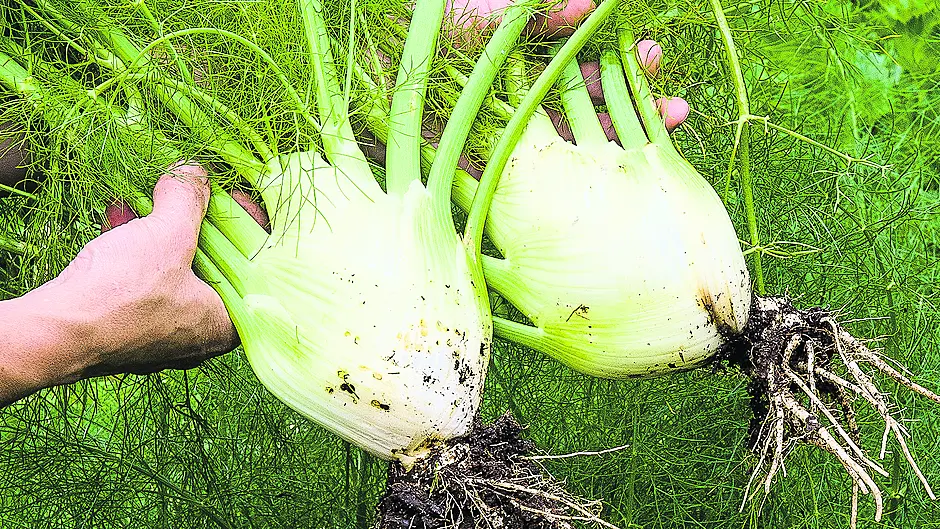BY JOYCE RUSSELL
WE have had some very wet and wild weather of late and the ground is saturated. It can take a while for things to dry out, even if we get a few dry days. Don’t be in a rush to start digging in feeds and turning soil over – you can do more harm than good, unless your beds are very well drained. Things should improve over the next couple of weeks and there is plenty of time to start thinking about planting new crops. Fingers crossed that we get some better gardening weather as spring starts to come into its own.
Harvesting leeks
The outer layers of leeks may have already started to deteriorate and plants produce a hard shoot up the middle if they start to bolt. Neither of these are desirable, although you can peel back outer layers until you get down to a good white stem and you can remove the hard core and use what is left.
It’s a good idea to lift any leeks that are still in the ground. This can help to extend the useable life of the crop and it can also free up a bed for when spring planting starts.
Use a fork and ease out some roots along with the top of the plant. You can heel plants back into a hole or trench – cluster several together; they don’t need nutrients, they just need for roots to be covered with soil and kept damp. Breaking the roots slows down bolting, but you should still aim to use the crop as soon as you can.
Greenhouse growing
• Remove any salad rows that produce flower spikes. The leaves will be bitter and new rows sown now will soon produce small sweet leaves to harvest.
• If you grew fennel through the winter then lift and use any remaining plants. These will bolt and the bulb will get stringy and tough if left to grow for much longer. Always peel layers apart and check that there aren’t any slugs, earwigs etc – these often take up residence in winter plants grown under cover.
• Cabbage and broccoli leaves can be affected by grey mould when grown in a poorly ventilated space. Plants should be coming into their own and producing valuable crops from hereon so you want to give them the best chance that you can. Remove any mouldy leaves (or parts of leaves) and aim to keep plenty of healthy ones to grow on. Open a door or window whenever you can and especially on bright sunny days when temperatures can rise rapidly in an enclosed space. Keep leaves dry if possible and don’t let plants press against polythene or glass.
Greenhouse sowing
Sow peppers and tomatoes at 20C if you haven’t done so already. Wait until mid-March to sow cucumbers. These do better from a slightly later start and suffer from fewer losses through root rot.
This is a good time to sow leeks, beetroot and Brussels sprouts too. Starting these vegetables undercover means that they get off to a fast, healthy, start and plants can be planted outdoors to grow on when the weather allows.
Sow leeks thinly in a shallow tray and be ready to prick them out into deeper pots or tubs as they grow.
Sow beetroot at two or three seeds per cell (in a tray divided up into many individual cells) – this allows for minimal root disturbance when planting out and any seedlings can be thinned out to leave the strongest ones. Sow several brussels sprouts seeds in a tray or pot. These germinate quickly and can be pricked out into individual pots to grow on.
Plant a few early potatoes in buckets of compost. These get off to an early protected start in the greenhouse or polytunnel and you can always move them outdoors when things warm up, if you need the indoor space for other crops later on. This early sowing will give some delicious early potatoes before any come ready in the outdoor garden. I prefer to use buckets rather than grow potatoes in the greenhouse border – the latter increases the risk of blight spreading to tomato plants.
Tulips
Leaves are poking through the soil now. They grow rapidly and will bloom in a few weeks’ time. Make sure the young leaves are protected from pets and that they have plenty of light – tulip stems can grow tall and be inclined to flop at the best of times, so anything that avoids leggy weak growth is a bonus.
If older bulbs push up leaves that show signs of mould or brown spots, then act fast to lift and remove any affected ones. This type of botrytis may only attack tulips, but the spores can soon spread from one plant to the next.
Subscribe to the Southern Star's YouTube channel, like us on Facebook and follow us on Twitter and Instagram for all the latest news and sport from West Cork.






